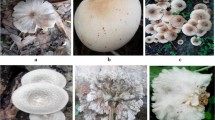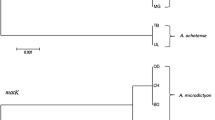Abstract
Morels are precious and rare edible mushroom, which contain 61 species. It is difficult to identify the species of morels based on morphological characteristics. In recent years, morels cultivation technology has made great progress, Morchella sextelata has been cultivated in China widely. In this study, a PCR-based approach was developed for identification of Morchella sextelata, based on a 190-bp segment of internal transcribed spacer (ITS). The species-specific primer, MS1F/MS1R, was designed based on the alignment of sequence obtained from the 20 representative cultivated body fruit of Morchella sextelata as well as 10 sequence data available in Genbank. Verifying the species-specific primer pair demonstrated generation of an amplicon from extracted DNA of Morchella sextelata. The primer pair was also applied and tested for five other species of morels and eight common mushrooms from other genus. This novel PCR assay allowed a rapid and effective quality evaluation of Morchella sextelata.


Similar content being viewed by others
References
Du XH, Zhao Q, O'Donnell K, Rooney AP, Yang ZL (2012) Multigene molecular phylogenetics reveals true morels (Morchella) are especially species-rich in China. Fungal Genet Biol 49(6):455–469
Jing HY (2018) The research progress of species identification of morels and health efficacy of active ingredients. J Anhui Agric Sci 46(14): 34–36, 140
Li SZ (2014) Compendium of Materia Medica. 2014. Beijing: People's Medical Publishing House 1999, pp 1718–1982
Ajmal M, Akram A, Ara A, Akhund S, Nayyar BG (2015) Morchella esculenta: an edible and health beneficial mushroom. Pak J Food Sci 25(2):71–78
Li SH, Gao A, Dong S, Chen Y, Sum S, Lei ZF et al (2017) Purification, antitumor and immunomodulatory activity of polysaccharides from soybean residue fermented with Morchella esculenta. Int J Biol Macromol 96:26–34
Li WJ, Tian Y, Gao H, Zhen DM, Dong CH, Qian ZM (2017) The Research Progress on Chemical Constituents and Pharmacological Activities of Morchella. J Fungal Res 15(2):144–150
Liu QZ, Ma HS, Zhang Y, Dong CH (2018) Artificial cultivation of true morels: current state, issues and perspectives. Crit Rev Biotechnol. 38(2):259–271
Masaphy S (2010) Biotechnology of morel mushrooms: successful fruiting body formation and development in a soilless system. Biotechnol Lett 32(10):1523–1527
O’Donnell K, Rooney AP, Mills GL, Kuo M, Weber NS, Rehner SA (2011) Phylogeny and historical biogergraphy of true morels (Morchella) reveals an early Cretaceous origin and high continental endemism and provincialism in the Holarctic. Fungal Genet Biol 48(3):252–265
Chai HM, Chen LJ, Chen WM, Zhao Q, Zhang XL, Su K, et al (2017) Characterization of mating-type idiomorphs suggests that Morchella importuna, Mel-20 and M. sextelataare heterothallic. Mycol Progress 16(7): 743–752
Chen JS, Zheng FC (2007) Application of ITS sequences in fungi classification and identification. J Anhui Agri Sci 35(13): 3785–3786,3792
Singh SK, Kamal S, Tiwari M, Yadav MC, Upadhyay RC (2004) Arbitrary primer based RAPD—a useful genetic marker for species identification in Morels. J Plant Biochem Biot 13(1):7–12
Du XH, Zhao Q, Yang ZL, Hansen K, Taskin H, Büyükalaca B et al (2012) How well do ITS rDNA sequences differentiate species of true morels (Morchella)? Mycologia 104(6):1351–1368
Lalitha S (2000) Primer Premier 5. Biotech Softw Internet Rep 1(6):270–272
Ye J, Coulouris G, Zaretskaya I, Cutcutache L, Rozen S, Madden TL (2012) Primer-BLAST: A tool to design target-specific primers for polymerase chain reaction. BMC Bioinform 13(1):134
Tietel Z, Masaphy S (2018) True Morels (Morchella)—nutritional and phytochemical composition, health benefits and flavor: a review. Crit Rev Food Sci 58(11):1888–1901
Han P, Chen QJ, He GQ, Wei JK, Zhang GQ, Wang SN et al (2018) Isolation, identification and mycelial culture conditions of two wild morels. J Beijing Univ Agric 33(1):37–42
Xiong C, Li XL, Li Q, Yang ZR, Zhang LY (2015) Research on life cycle, artificial cultivation and efficacy of Morels. Edible Fungi China 34(1):7–12
Yu DM, You WZ, Zhang Y, Wang KH, Hao JC, Peng QT (2018) Artificial cultivation of Morchella. J Liaoning For Sci Technol 288(02):51–54
Bunyard BA, Nicholson MS, Royse DJ (1994) A systematic assessment of Morchella using RFLP analysis of the 28S ribosomal RNA gene. Mycologia 86(6):762–772
Ta§kin H , Büyükalaca S, Hansen K, O'Donnell K (2012) Multilocus phylogenetic analysis of true morels (Morchella) reveals high levels of endemics in Turkey relative to other regions of Europe. Mycologia 104(2):446–461
Ajmal Ali M, Gyulai G, Hidvégi N, Kerti B, AI Hemaid FM, Pandey AK et al (2014) The changing epitome of species identification—DNA barcoding. Saudi J Biol Sci 21(3):204–231
Das S, Deb B (2015) DNA barcoding of fungi using Ribosomal ITS Marker for genetic diversity analysis: a review. Int J Pure App Biosci 3(3):160–167
Bellemain E, Carlsen T, Brochmann C, Coissac E, Taberlet P, Kauserud H (2010) ITS as an environmental DNA barcode for fungi: an in silico approach reveals potential PCR biases. BMC Microbiol 10(1):189
Liu Y, Wang XY, Gao ZT, Han JP, Xiang L (2017) Detection of Ophiocordyceps sinensis and its common adulterates using species-specific primers. Front Microbiol 8:1179
Liu W, Lan AF, Zhang QQ, Cai YL, Ma XL, Bian YB (2018) Genetic diversity analyses and species specificity RAPD-SCAR marker exploitation of the cultivated Morchella strains. Mycosystema 37(12):1650–1660
Acknowledgements
This study was supported by the promotion and protection project of Chinese herbal medicine of 2015 by MIIT (No. 2017020)
Author information
Authors and Affiliations
Corresponding authors
Ethics declarations
Conflict of interest
The authors declare that they have no conflicts of interest.
Additional information
Publisher's Note
Springer Nature remains neutral with regard to jurisdictional claims in published maps and institutional affiliations.
Electronic supplementary material
Below is the link to the electronic supplementary material.
Rights and permissions
About this article
Cite this article
Shen, Q., Li, C., Xie, M. et al. A Novel PCR-Based Approach for Rapid Identification of Morchella sextelata Using Species-Specific Primers. Curr Microbiol 77, 232–237 (2020). https://doi.org/10.1007/s00284-019-01819-0
Received:
Accepted:
Published:
Issue Date:
DOI: https://doi.org/10.1007/s00284-019-01819-0




